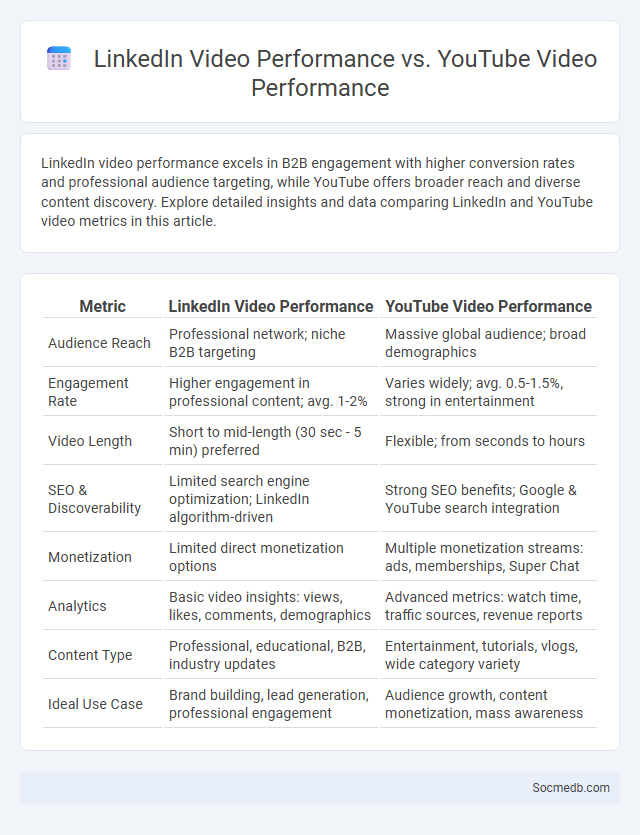
Photo illustration: LinkedIn Video Performance vs YouTube Video Performance
LinkedIn video performance excels in B2B engagement with higher conversion rates and professional audience targeting, while YouTube offers broader reach and diverse content discovery. Explore detailed insights and data comparing LinkedIn and YouTube video metrics in this article.
Table of Comparison
| Metric | LinkedIn Video Performance | YouTube Video Performance |
|---|---|---|
| Audience Reach | Professional network; niche B2B targeting | Massive global audience; broad demographics |
| Engagement Rate | Higher engagement in professional content; avg. 1-2% | Varies widely; avg. 0.5-1.5%, strong in entertainment |
| Video Length | Short to mid-length (30 sec - 5 min) preferred | Flexible; from seconds to hours |
| SEO & Discoverability | Limited search engine optimization; LinkedIn algorithm-driven | Strong SEO benefits; Google & YouTube search integration |
| Monetization | Limited direct monetization options | Multiple monetization streams: ads, memberships, Super Chat |
| Analytics | Basic video insights: views, likes, comments, demographics | Advanced metrics: watch time, traffic sources, revenue reports |
| Content Type | Professional, educational, B2B, industry updates | Entertainment, tutorials, vlogs, wide category variety |
| Ideal Use Case | Brand building, lead generation, professional engagement | Audience growth, content monetization, mass awareness |
Introduction to LinkedIn vs YouTube Video Platforms
LinkedIn is a professional networking platform designed for career development, job searching, and B2B marketing, emphasizing industry-specific content and professional connections. YouTube serves as a vast video-sharing site where users upload, view, and engage with diverse multimedia content, targeting broad audiences with entertainment, tutorials, and vlogs. Both platforms leverage video formats but cater to distinct user intents: LinkedIn prioritizes professional and educational videos, while YouTube focuses on entertainment and broad audience engagement.
Video Distribution Algorithms: LinkedIn Feed Ranking vs YouTube Recommendations
Video distribution algorithms on social media platforms significantly influence content visibility, with LinkedIn feed ranking prioritizing professional relevance and user engagement signals such as connections, comments, and shares. YouTube recommendations utilize machine learning to analyze watch history, video metadata, and viewer retention metrics, aiming to maximize watch time and personalized content discovery. Understanding these differing algorithmic priorities allows content creators to tailor videos effectively for LinkedIn's career-oriented audience or YouTube's broad entertainment-seeking users.
Audience Demographics and Targeting
Understanding audience demographics on social media platforms allows you to tailor content and advertising to specific age groups, locations, interests, and behaviors for enhanced engagement. Platforms like Facebook, Instagram, and LinkedIn offer detailed targeting options that help your campaigns reach the most relevant users efficiently. Leveraging these demographic insights maximizes your return on investment and improves overall marketing effectiveness.
Engagement Metrics: Likes, Comments, and Shares
Engagement metrics such as likes, comments, and shares are crucial indicators of your social media content's effectiveness in reaching and resonating with your audience. Likes provide a quick signal of approval, while comments offer deeper insights into user opinions and encourage community interaction. Shares amplify your content's visibility by distributing it through users' personal networks, significantly boosting organic reach and brand awareness.
Video Format & Length Optimization
Optimizing video format and length for social media platforms enhances engagement by aligning content with user preferences and technical specifications. Short-form videos, typically under 60 seconds, perform best on platforms like TikTok and Instagram Reels, maximizing viewer retention and shareability. Using widely supported formats such as MP4 with H.264 codec ensures compatibility across devices and faster loading times, improving overall user experience.
Organic Reach and Visibility Differences
Organic reach on social media refers to the number of people who see your content without paid promotion, relying solely on the platform's algorithm and your followers' engagement. Visibility differences occur because each platform prioritizes different types of content, such as videos on TikTok or images on Instagram, which directly impacts how many users organically discover your posts. Understanding these nuances can help you tailor your strategy to maximize your organic reach and enhance your overall social media presence.
Performance Analytics: What Metrics Matter Most?
Performance analytics in social media centers on key metrics such as engagement rate, reach, and conversion rates to measure the effectiveness of your campaigns. Tracking click-through rates (CTR) and audience demographics provides deeper insights into user behavior and content resonance. Prioritizing these data points helps optimize strategies and maximize your social media impact.
Algorithmic Priorities: What Each Platform Promotes
Social media platforms prioritize content differently based on their unique algorithms, influencing what users see most. Facebook favors posts that generate meaningful interactions, such as comments and shares, while Instagram emphasizes visually engaging content and recency to keep users scrolling. Understanding these algorithmic priorities can help you optimize your content strategy to increase visibility and engagement across platforms.
Best Practices for Maximizing Video Performance
Optimizing video content for social media involves creating engaging thumbnails, using captions for accessibility, and maintaining a concise duration tailored to the platform's audience. You should also leverage platform-specific features such as Instagram Reels, TikTok's trending sounds, and Facebook's video autoplay to increase visibility. Consistent posting schedules and analyzing performance metrics like view duration and engagement rates help refine your strategy and maximize video performance.
Conclusion: Choosing the Right Platform for Your Goals
Selecting the right social media platform hinges on understanding your target audience, content type, and business objectives. Platforms like Instagram excel in visual storytelling, while LinkedIn offers powerful tools for professional networking and B2B marketing. You can maximize engagement and ROI by aligning your strategy with the platform that best supports your goals.
 socmedb.com
socmedb.com